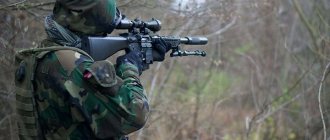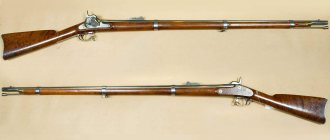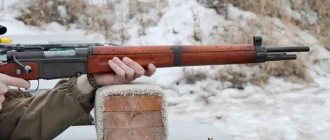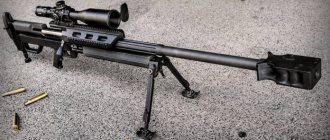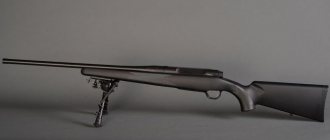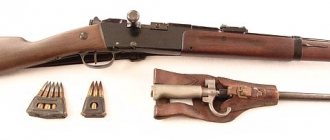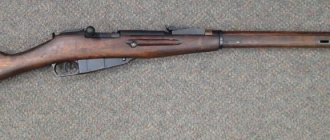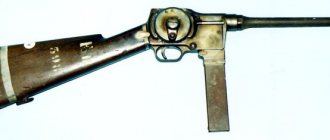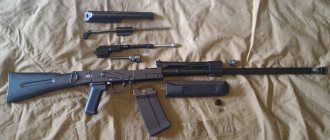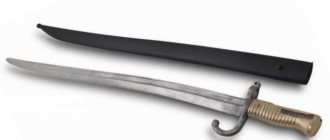Rifles, carbines, shotguns
In 1949, the state arsenal in France developed a rifle under the designation Fusil Automatique MAS 1949, which was adopted by the French army as the main one.
Since at that time the French army did not have a special sniper weapon, the MAS-1949 began to be used as a standard sniper rifle. The MAS 49 automation is based on the principle of removing powder gases to the bolt frame. The gas exhaust mechanism had no moving parts. The barrel bore was locked by tilting the rear part of the bolt downwards. The trigger mechanism is a hammer type and allows only single fire. The safety is located on the right side of the rifle in front of the trigger guard. The rifle was fed from detachable box magazines with a capacity of 10 rounds. Loading was done from standard five-round plate clips.
The weapon had a mechanical sighting device - a sector diopter sight, designed for a range of 1200 m. All rifles were equipped with a mount for a 3.85x optical sight ARX L806, later designated model 1953. For firing in twilight and night conditions, a special one was attached to the barrel of the weapon a slotted flash suppressor on which sighting devices with phosphorescent dots were mounted, ensuring targeted shooting at a distance of up to 100 m.
Subsequently, the design of the MAS 49 rifle was slightly modernized, the new model received the designation “MAS 49-56”. Mass production of the rifle began in 1958. The modernized version had a higher rate of fire - 25-40 aimed rounds per minute. Just like the MAS 49, the MAS 49-56 was used as a standard sniper rifle.
But ill-conceived balancing of the center of gravity, which was caused by the operation of the moving parts of the rifle’s automatic system during shooting, negatively affected the accuracy of the battle in comparison with sniper rifles with mechanical reloading. Therefore, the MAS 49-56 served mainly for firing at distant targets that appeared in the shooter’s field of view for a short period of time.
The MAS 49/56 sniper rifle was used by the French army until the late 1970s, when it was replaced by the FAMAS 5.56mm NATO assault rifle. Sniper rifles MAS-1949 and MAS-1949/56 were widely used by the French army in the wars in Indochina (Vietnam) and Algeria, where they showed such qualities as reliability, good shooting accuracy and ease of use.
- Cartridge: 7.5×54
- Weight: 4.5 kg
- Length: 1010 mm
- Barrel length: 521 mm
- Magazine capacity: 10 rounds
- Sighting range: 600 m
- Back
- Forward
Contact CIA
The Office of Public Affairs (OPA) is the single point of contact for all inquiries about the Central Intelligence Agency (CIA).
We read every letter, fax, or e-mail we receive, and we will convey your comments to CIA officials outside OPA as appropriate. However, with limited staff and resources, we simply cannot respond to everyone who writes to us.
Contact Information
By postal mail:
Central Intelligence Agency Office of Public Affairs Washington, DC 20505
Before contacting us:
Please check our site map
,
search
feature, or
our site navigation on the left
to locate the information you seek. We do not routinely respond to questions for which answers are found within this Web site.
Employment:
We do not routinely answer questions about employment beyond the information on this Web site, and we do not routinely answer inquiries about the status of job applications. Recruiting will contact applicants within 45 days if their qualifications meet our needs.
- Because of safety concerns for the prospective applicant, as well as security and communication issues, the CIA Recruitment Center does not accept resumes, nor can we return phone calls, e-mails or other forms of communication, from US citizens living outside of the US . When you return permanently to the US (not on vacation or leave), please visit the CIA Careers page and apply online for the position of interest.
- To verify an employees' employment, please contact the Employment Verification Office.
The rifle was developed taking into account the experience of the First World War and local colonial combat clashes of the early 20th century as a universal small arms of the ground forces, intermediate between a rifle and a carbine, equally suitable for maneuverable combat (including in the jungle, populated areas - thanks to its successful layout, relatively small weight and dimensions) and positional warfare (the experience of the First World War of 1914-1918 showed that shooting from rifles - except for snipers with optical sights - is carried out mainly lying down or standing from a trench at distances of up to 1000 m and maneuverability is more important for infantry weapons range) [2]. The first prototype of the rifle (named Modèle 1934B2
") [1] was manufactured in 1935 [6].
Entered into service on March 17, 1936, the rifle was extremely technologically advanced in production [1].
MAS-36 was produced for the French army and the Foreign Legion in 1937-1940. (at the same time, mass production began only on March 31, 1938 [7] and by September 1, 1939, 101 thousand rifles were manufactured [8]). Until June 1940, 250 thousand rifles were manufactured [9].
Sniper rifle MAS 49 / MAS 49-56
In 1949, the state arsenal in Saint-Etienne - Manufacture Nationale d'Armes de St-Etienne (MAS) developed a universal rifle under the designation Fusil Automatique MAS 49, which was adopted by the French army as the main rifle.
Since there were no special sniper weapons in the French Armed Forces at the moment, the MAS 49 was used as a standard sniper rifle.
For this purpose, the MAS 49 rifles were equipped with a mount for the 3.85x APX L806 optical sight, later known as the Model 1953.
The effective firing range of the MAS 49 sniper version was 600 meters.
Report Information
People from nearly every country share information with CIA, and new individuals contact us daily. If you have information you think might interest CIA due to our foreign intelligence collection mission, there are many ways to reach us.
If you know of an imminent threat
to a location inside the US, immediately contact your local law enforcement or
FBI Field Office
.
For threats outside the US, contact CIA
or go to a US Embassy or Consulate and ask for the information to be passed to a US official. Please know, CIA does not engage in law enforcement.
In addition to the options below, individuals contact CIA in a variety of creative ways. The best method depends on your personal situation. We will work to protect all information you provide, including your identity, and our interactions with you will be respectful and professional. Depending on what you provide, we may offer you compensation.
WHAT TO PROVIDE
If you feel it is safe, consider providing these details with your submission:
- Your full name
- Biographical details, such as a photograph of yourself, and a copy of the biographical page of your passport
- How you got the information you want to share with CIA
- How to contact you, including your home address and phone number
We cannot guarantee a response to every message. We reply first to messages of greater interest to us and to those with more detail. Our response will occur via a secure method.
Beretta BM59
Beretta BM59
After World War II, the Italians adopted the American M1 Garand, which can safely be called an automatic rifle, although it does not have a choice of fire mode or interchangeable magazine.
Italy loved the M1 so much that in the 50s, when the rest of the world was switching to 7.62 mm automatic rifles, Beretta redesigned the M1 to 7.62 x51, adding selectable fire mode and a 20-round box magazine.
An added benefit was that the weapon used the same parts as the M1 (which Italy had in abundance). As a result, the Italian military received a 9.4 kg rifle that was used throughout the Cold War, even exporting it to Mexico, Indonesia and Argentina, where it is still used today. Among automatic rifles, the BM59 was one of the last to be withdrawn from service. In the 1990s it replaced the AR70/90 caliber 5.56 x 45 mm.
Approval of the Menier rifle
The long recoil energy of the semi-automatic Menier rifle was adopted in 1910 to replace the Lebel rifle. This gave excellent performance during recent testing: "The 7mm Meunier Rifle fired 3,000 rounds without serious incident."
The A6 Menier rifle was adopted in 1910, but its final ammunition specifications were not specified except for the 7 mm caliber. There were endless debates between the state arsenals at Puteaux and Tulle regarding body length and bullet velocity. The final choice for a case length of 56.95 mm (2.242 in) was made in 1912, and the original loading delivered a muzzle velocity in excess of 1,000 meters per second. A lighter load was finally chosen in 1913, allowing the final adoption of the A6 Menier rifle. The outbreak of World War I in August 1914 brought an end to the project, which would have equipped the French army with the first semi-automatic infantry rifle.
ammunition
The Rimless 7x59mm Menier round was significantly more powerful than the 8mm Lebel.
The 7x59mm Meunier had a muzzle velocity of 3,412 ft/s (+1,040 m/s). It had a steel core as well as 7x57mm (7.2x56.95mm), adopted the same year and retained later for the Menier rifle of 1916 with a velocity reduced to 2,690 ft/s (820 m/s).
Atelier de construction de Puteaux
a cartridge was made near Paris; most of the rare examples known are marked APX 1917.
Rifle production
During the spring of 1914, MAS prepared to undertake the production of 5,000 Menier rifles every month, but the decision to begin mass production was canceled due to the risk of introducing a new system at a time when conflict with Germany seemed inevitable. Eventually, 1013 Meunier rifles were manufactured at the Tulle Arsenal (MAT) by the time World War II broke out; they were tested in trenches. Only 1,013 were ever manufactured, and most were lost in the First World War. The rifles that survived the First World War (and post-war military re-equipment years) ended up in museums, most of them deactivated. Of these few rifles that survived, almost all were looted and/or lost during World War II. For surviving examples as of 2022, see the section below.
The carbine version is said to have been manufactured according to Jean Huon, in his book "Proud Promise". He claims that 3 were made by cutting long rifles. One of these Carbines exists today in the collection of the Springfield Armory in Massachusetts, USA. It's not on the display.
Links[edit]
- https://www.thetruthaboutguns.com/2011/08/joe-grine/gun-review-mas-4956-fusil-semi-automatique-modele-1949-1956/
- ^ abcdefgh Yuon, Jean; A Proud Promise - French Semi-Automatic Rifles: 1898–1979
, Collector's Grade Publications, 1995. ISBN 0-88935-186-4. - ↑ Manuel du Grade TTA 116
(in French). Berger-Levro. 1956-03-19. paragraph 213. - (Huon, 1995)
- McCollum, Ian (24 May 2019). "Forgotten Weapons, Latest Iteration of the French Battle Rifle: MAS 49-56". Youtube.com
. Retrieved April 29, 2022. - [1]
- [2]
- Gas valve MAS 49/56 adj
- MAS 49/56 Adjustable gas valve
- Barnes, Frank S., Cartridges of the World, DBI Books Inc. (1989)
- ^ ab Bonn International Conversion Center; Bundeswehr Verification Center. "MAS 49". Guide to SALW: Global Dissemination and Visual Identification
. Retrieved August 29, 2022. - ^ abcde "Use of the MAC-36 rifle after World War II: Part II (export users)". wwiiafterwwii.wordpress.com
. 2015-08-23. Retrieved June 15, 2022. - Jump up
↑ Gander, Terry J. (November 22, 2000).
"National inventories, Benin". Jane's Infantry Weapons 2001-2002
. - Jump up
↑ Gander, Terry J. (November 22, 2000).
"National inventories, Burkina Faso". Jane's Infantry Weapons 2001-2002
. - Jump up
↑ Gander, Terry J. (November 22, 2000).
"National inventories, Central African Republic". Jane's Infantry Weapons 2001-2002
. - Berman, Eric G.; Lombard, Louise N. (December 2008). Central African Republic and Small Arms: A Regional Tinderbox (PDF). Small Arms Review. pp. 43–44. ISBN 2-8288-0103-9.
- Jump up
↑ Gander, Terry J. (November 22, 2000).
"National inventories, Comoros". Jane's Infantry Weapons 2001-2002
. - Jump up
↑ Gander, Terry J. (November 22, 2000).
"National inventories, Congo". Jane's Infantry Weapons 2001-2002
. - "MAS M1949 Rifle". iwm.org.uk.
_ Imperial War Museum. Retrieved February 19, 2022. - Scarlata, Paul (1 March 2009). "Ethiopian Military Rifle Ammo: Part 2: From Mauser to Kalashnikov". Shotgun News
. - De Tessières, Savannah (April 2012). Enquête nationale sur les armes légères et de petit caliber in Côte d'Ivoire: the fight against guns and the fight against violence since the electoral war (PDF) (Report). Special Report No. 14 (in French). UNDP, National Commission to Combat the Proliferation and Illicit Trafficking of Legal Weapons and Small Calibers and Small Arms Review. paragraph 97.
- Jump up
↑ Gander, Terry J. (November 22, 2000).
"National inventories, Côte d'Ivoire". Jane's Infantry Weapons 2001-2002
. - Scarlata, Pavel (July 2009). "Lebanese Military Rifle Ammo Part 2: From Independence to Hezbollah". Shotgun News
. - Scarlata, Paul (December 2012). "Madagascar's military rifle cartridges are isolated but well armed!" . Shotgun News
. - Jump up
↑ Gander, Terry J. (November 22, 2000).
"National inventories, Mali". Jane's Infantry Weapons 2001-2002
. - Bonn International Conversion Center; Bundeswehr Verification Center. "MAS 49/56". Guide to SALW: Global Dissemination and Visual Identification
. Retrieved August 29, 2022. - Jump up
↑ Gander, Terry J. (November 22, 2000).
"National inventories, Mauritania". Jane's Infantry Weapons 2001-2002
. - Giletta Jacques (2005). Les Gardes Personnelles des Princes de Monaco
(1st ed.). Taurus editions. ISBN 2 912976-04-9. - Jump up
↑ Gander, Terry J. (November 22, 2000).
"National inventories, Niger". Jane's Infantry Weapons 2001-2002
. - Jump up
↑ Gander, Terry J. (November 22, 2000).
"National Inventories, Rwanda". Jane's Infantry Weapons 2001-2002
. - Jump up
↑ Gander, Terry J. (November 22, 2000).
"National inventories, Senegal". Jane's Infantry Weapons 2001-2002
. - Jump up
↑ Gander, Terry J. (November 22, 2000).
"National Inventories, Seychelles". Jane's Infantry Weapons 2001-2002
. - Popenker, Maxim (28 October 2010). "MAS-1949 and 49/56". Modern firearms
. - Scarlata, Paul (February 2010). "Syria Military Rifle Ammo". Shotgun News
. - Scarlata, Paul (November 2012). "Military rifle cartridges of Tunisia: from the Phoenicians to the present day". Shotgun News
. - Abbott, Peter; Botham, Philip (1986). Modern African Wars (1) 1965-80: Rhodesia 1965-80
. paragraph 10. ISBN 0850457289.
- Barnes, Frank S., Cartridges of the World
, DBI Books Inc. (1989). - Yuon, Jean; A Proud Promise - French Semi-Automatic Rifles: 1898–1979
, Collector's Grade Publications, 1995. ISBN 0-88935-186-4. - Smith, W.H.B.; Small Arms of the World
(1967). - Walter, John; Rifles of the World, 3rd edition
(2006).
Gas mechanism
The rifle was created on the basis of early developments of the first half of the 20th century using direct exhaust of powder gases to the bolt frame. Prototypes appeared in the 1920s and 1930s, and several MAS 44 rifles were produced after the Germans withdrew from France in 1944 and were used for comparative testing.
Although the MAS 49 uses the principle of removing powder gases, there is no tube or piston in the design: the powder gases are diverted through an opening in the bore into the gas chamber, from where they enter the bolt carrier, pushing it back. This system has not become widespread because it is prone to rapid contamination. However, in MAS 49 this was not a big problem. The bolt was locked in the same way as on the Belgian Model 49 rifle - by tilting.
Syrian contract rifles[edit]
Syria has signed a contract with MAS for 6,000 MAS-49 rifles. These rifles, as well as 12,000 MAS-36 rifles and a workshop for the production of 7.5x54 mm ammunition, were delivered in the early 1950s. MAS-49s were used until the mid-60s, when they were replaced by AK-47 assault rifles. [6] The Syrian contract rifles differed from the French service model in that they had a spike bayonet identical to that of the MAS-36, [2] as well as different stocks and metal parts to accommodate this change. These rifles date back to 1953 and have serial numbers ranging from F33.000 to F39.000. [7]
Users
- Algeria[2]
- Benin: MAS-49[11] and MAS-49/56[12][13]
- Burkina Faso: MAS-49/56[14]
- Cameroon: MAS-49/56[12]
- Central African Republic:[15] 60 MAS-49/56 in service in 1963 with the Gendarmerie[16]
- Comoros: MAS-49/56[17]
- Congo: MAS-49/56[18]
- EOKA: Stolen MAS-49s were used during the Cyprus Emergency[19]
- Eritrean Liberation Front: received MAS-49/56 via French Djibouti[20]
- France[2]
- Ivory Coast: MAS-49/56[12][21][22]
- Gabon: MAS-49/56[12]
- Lebanon: MAS-49 and MAS-49/56[23]
- Madagascar[24]
- Mali: MAS-49/56[25]
- Mauritania: MAS-49/56[26][27]
- Monaco Compagnie des Carabiniers du Prince
: MAS-49[28][11] - Morocco: MAS-49/56[12]
- Niger: MAS-49/56[29]
- Rwanda: MAS-49/56[30]
- Senegal: MAS-49/56[31]
- Seychelles: MAS-49/56[32]
- Syria[33][34]
- Tunisia: MAS-49 and MAS-49/56[35]
- North Vietnam Captured from France
- Zimbabwe [36]

